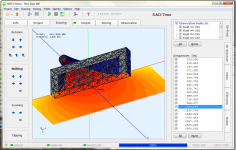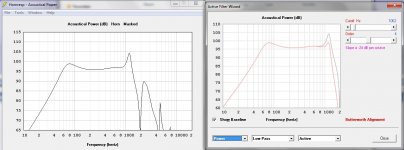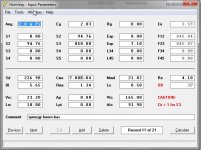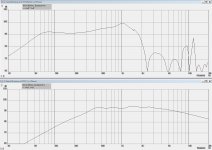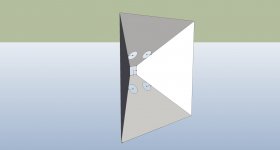I have drawn the horn but is is short, but very wide, (1 meter), with heigh is 10 cm.
I do try more height to see what happens, I do not understand the throat is so wide, while for he high it is much smaller, hornresp do take this with them
regards
That looks like a Danley SM100 style "waveguide" given how shallow it is. Does HR predict off axis polar directivity?
Time for stepping up to ABEC3?
I was just checking out ABEC3 (the 3d FEA acoustics modeling package from makers of Akabak) and it seems to be really what I need to start using to model horns properly. Especially if one wants to take into account finer details like phase plug geomtery and accurate polar directivity. Here is a screenshot of the calculation of a sample exponential horn with ABEC3. It is a complex package but appears manageable given all the examples provided and it is GUI based (there are still aspects that are script based though).
There is no question of whether it is plane wave or isowave - no assumptions as this is boundary finite element solver.
ABEC3 - Demo Version
If you are a student there is a non-commercial license available.
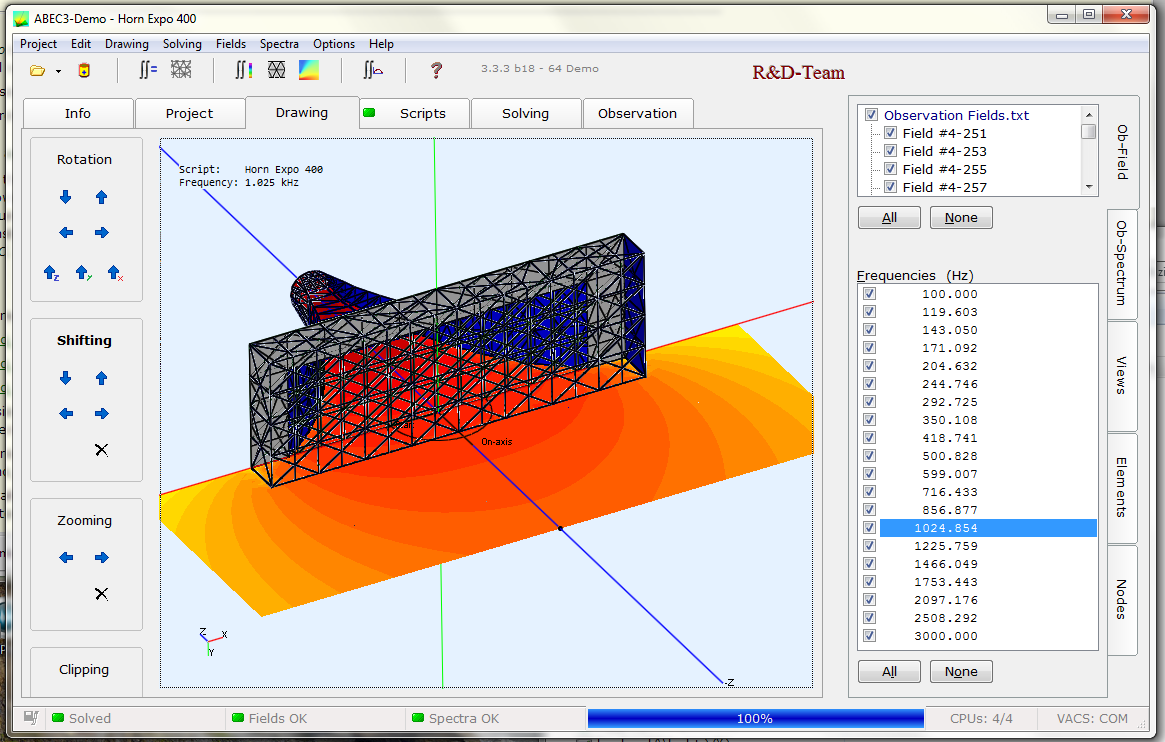
I was just checking out ABEC3 (the 3d FEA acoustics modeling package from makers of Akabak) and it seems to be really what I need to start using to model horns properly. Especially if one wants to take into account finer details like phase plug geomtery and accurate polar directivity. Here is a screenshot of the calculation of a sample exponential horn with ABEC3. It is a complex package but appears manageable given all the examples provided and it is GUI based (there are still aspects that are script based though).
There is no question of whether it is plane wave or isowave - no assumptions as this is boundary finite element solver.
ABEC3 - Demo Version
If you are a student there is a non-commercial license available.

Attachments
I have did a sim this time with corrected horn incl tweeter section, then I get a peak on 1.1 Khz. but with filter it can be removed.
I think woofers 6 to 8 inch with heavy cone and a tweeter with FS of 500 hz wil do nice.
making the horn is more difficult but use thin wood panels wil do by glue the on each order to make a thick exponential panel, under and upside is flat wood, witj conic flare.
I think woofers 6 to 8 inch with heavy cone and a tweeter with FS of 500 hz wil do nice.
making the horn is more difficult but use thin wood panels wil do by glue the on each order to make a thick exponential panel, under and upside is flat wood, witj conic flare.
Attachments
I have did a sim this time with corrected horn incl tweeter section, then I get a peak on 1.1 Khz. but with filter it can be removed.
I think woofers 6 to 8 inch with heavy cone and a tweeter with FS of 500 hz wil do nice.
making the horn is more difficult but use thin wood panels wil do by glue the on each order to make a thick exponential panel, under and upside is flat wood, witj conic flare.
Can you show drawing with where your woofer injection ports are located? I don't understand what you mean by adding tweeter section to horn? The tweeter is at the apex and that is in the geometry already, no?
Martinsson stuck a 2in fullrange Tang Band driver on a JBL horn and got the following response which clearly shows usable output to 15kHz:


More info in this thread: http://www.diyaudio.com/forums/full-range/205146-2-madness-hornloading-tb-w2-803sm.html
I built my first Unity horn in 2006.
Before I trashed the waveguides, I moved one of the four midranges from the taps, where they are in a Unity horn, to the apex.
Yes, it works. You can cover about 500hz to 15khz with one 2" driver. That's five octaves.
But what's the point? After applying EQ, the efficiency is about 80dB, maximum output is about 90dB. The sound is very similar to my cel phone; my cel phone can cover five octaves.
IE, this would be a neat solution if you were building a very large intercom, or you were working to amplify a cel phone. But the maximum output is severely limited; it's about 30dB less than a Unity or Synergy horn.
I built my first Unity horn in 2006.
Before I trashed the waveguides, I moved one of the four midranges from the taps, where they are in a Unity horn, to the apex.
Yes, it works. You can cover about 500hz to 15khz with one 2" driver. That's five octaves.
But what's the point? After applying EQ, the efficiency is about 80dB, maximum output is about 90dB. The sound is very similar to my cel phone; my cel phone can cover five octaves.
IE, this would be a neat solution if you were building a very large intercom, or you were working to amplify a cel phone. But the maximum output is severely limited; it's about 30dB less than a Unity or Synergy horn.
Impressive cell phone you have that can put out 500Hz to 15kHz with 90dB max SPL.
This is Martinsson's experiment which I was using to show that 15kHz was achievable with a fullrange driving a horn. In my case, the PRV driver is much more capable of higher SPL's (225 watt max with 95dB sensitivity). Furthermore, it would not sound like a cellphone as there will be a couple of 12in 100dB sensitive pro woofers to provide the mid-bass from 100Hz to 300Hz.
I think the biggest problem will be as you and JLH pointed out that the directionality will suffer off axis.
Impressive cell phone you have that can put out 500Hz to 15kHz with 90dB max SPL.
The first time that I saw someone use an iPhone as a boombox, I knew that the world had changed
For domestic listening, oftentimes this is enough as 75dB to 80dB is typical and that gives 10dB headroom.
The interior of a VW Golf is 72dB when cruising down the freeway. 75dB is an extraordinarily low target.
This is Martinsson's experiment which I was using to show that 15kHz was achievable with a fullrange driving a horn. In my case, the PRV driver is much more capable of higher SPL's (225 watt max with 95dB sensitivity). Furthermore, it would not sound like a cellphone as there will be a couple of 12in 100dB sensitive pro woofers to provide the mid-bass from 100Hz to 300Hz.
I think the biggest problem will be as you and JLH pointed out that the directionality will suffer off axis.
I think the biggest problem will be higher order modes. There's a massive discontinuity between the cone and the horn walls, and this will generate tons of HOMs
The interior of a VW Golf is 72dB when cruising down the freeway. 75dB is an extraordinarily low target.
That is why I said domestic, as in a quiet home, at muzak levels.
I think the biggest problem will be higher order modes. There's a massive discontinuity between the cone and the horn walls, and this will generate tons of HOMs.
Agreed. I think this is where a phase plug molded to the contours of the cone and dustcap may be useful to turn it into a 5 in paper-diaphragm compression driver.
That is why I said domestic, as in a quiet home, at muzak levels.
Agreed. I think this is where a phase plug molded to the contours of the cone and dustcap may be useful to turn it into a 5 in paper-diaphragm compression driver.I think some work by Edgar on his horn used Scotchbrite pads near the throat as HOM equalizers a la Geddes...
Believe me, I've been down this road before.
You have two options to get to 15khz:
1) Option one is the hardest. You make a phase plug. The phase plug takes the radiation off of the cone and concentrates it into the throat. The trick with the phase plug is getting the paths equidistant. For instance, to keep the sound in-phase at 15khz the maximum pathlength difference is 0.225"
Let that sink in for a minute.
Your pathlengths must not vary more than 0.225".
Once you understand that, you'll understand that option one is impossible. Greater minds have failed; JBL has some 4" compression drivers, but they're Beryllium
2) Option two is to skip the phase plug entirely. That's what the other poster did with their 2" Tangband.
In this scenario, you need a seamless transition from the diaphragm to the waveguide walls and a flat diaphragm.
In both scenarios, a smaller diaphragm will extend high frequency response, because a smaller diaphragm has pathlengts that are more in-phase than a larger diaphragm. IE, if you have a 5" diaphragm the sound from the edge of the cone is not in phase with the sound from the center of the cone, due to simple geometry.
Can you show drawing with where your woofer injection ports are located? I don't understand what you mean by adding tweeter section to horn? The tweeter is at the apex and that is in the geometry already, no?
Yes tweeter is where the compression driver is normally, bass port is 8 cm from
compression driver, in my case a normal tweeter and has 165 cc and is 1.80 cm long, (thickness of used wood.) back is closed if I interpretere hornresp right, (I'm quite new in speaker thingies).
I do see it is a strange horn, 1 meter wide and 10 cm high, it is even not possible I think so I maybe need conic for all parts to fit woofers. I think ports are in the middle on both conic panels as I see it right in hornresp, I do not now what happens when in corners, hornresp do not sim that.
Maybe i have highjacked hornresp to improper sims, same for akabak.
see picture.
regards
Attachments
Last edited:
I have drawn a conic version who do also work oke, these has a cone tweeter from visaton and the two phillips, however the phillips are a little to big so need a longer horn (3 cm total).
Do not now if I need two holes each side or just one gap.
Do not now if I need two holes each side or just one gap.
Attachments
I have drawn a conic version who do also work oke, these has a cone tweeter from visaton and the two phillips, however the phillips are a little to big so need a longer horn (3 cm total).
Do not now if I need two holes each side or just one gap.
That sure looks familiar
http://www.diyaudio.com/forums/full-range/223313-foam-core-board-speaker-enclosures-200.html#post3698230
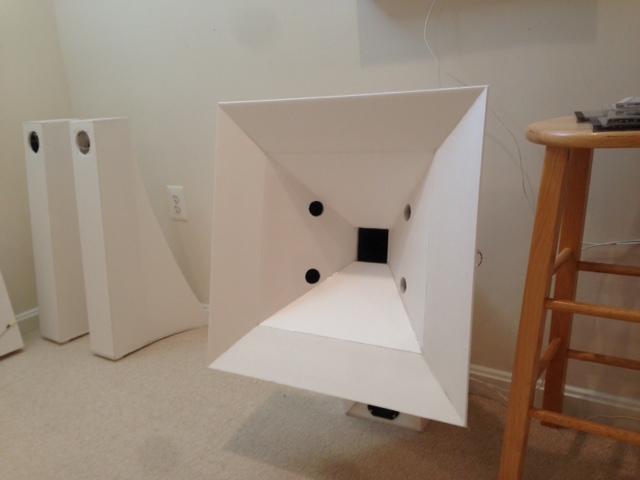
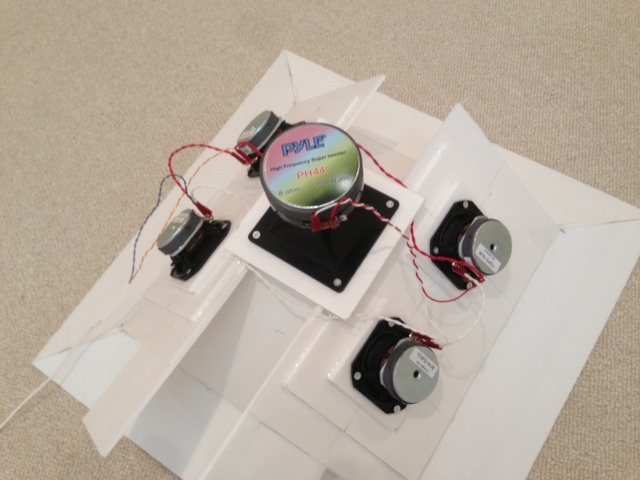
Unlike the rest of the 23__ series horn, the 2386 does not have a pinched diffraction throat, so the throat angle of the driver itself determines VHF dispersion. The JBL 2441 and 2445 have about an 11 degree angle, the "staggering" VHF DI is actually that of the driver, not the horn.Look at the spec sheet for the JBL 2386 horn: http://www.sound-image.com/wp-content/uploads/JBL_2386.pdf
Once again you notice the restricted directivity? The directivity index goes from 5.4 at 300Hz and up to a staggering 19.50 at 20KHz.
The actual acoustical source of the VHF emmitted from the 2" Tang Band driver Martinsson used would impact the HF dispersion, I'd expect it would be quite different than the polar response using a 2445.
can i use drivers with rubber surround, like S6.5R? are they difficult to mount?
Overview S6.5R Bass-Midrange_HiVi, Inc.
how many shall i use? if I use 2, then series, if I use 4, then 2 series + another pair in parallel?
Overview S6.5R Bass-Midrange_HiVi, Inc.
how many shall i use? if I use 2, then series, if I use 4, then 2 series + another pair in parallel?
Last edited:
BL is quite low on those drivers, not a good choice for horn load in general.can i use drivers with rubber surround, like S6.5R? are they difficult to mount?
Overview S6.5R Bass-Midrange_HiVi, Inc.
how many shall i use? if I use 2, then series, if I use 4, then 2 series + another pair in parallel?
The amount of drivers depend on your SPL requirements, doubling drivers and power gives +6 dB.
Wiring depends on what impedance your amp is happy with.
Your series parallel description sounds wrong, in no case would you want 2 series and another pair in parallel, the two pairs would get unequal amounts of power.
can i use drivers with rubber surround, like S6.5R? are they difficult to mount?
Overview S6.5R Bass-Midrange_HiVi, Inc.
how many shall i use? if I use 2, then series, if I use 4, then 2 series + another pair in parallel?
Read Post #3 of 1,756:
http://www.diyaudio.com/forums/mult...cone-bandpass-mid-unity-horn.html#post1029496
Yes is does! only mine has to go to 80 Hz, because of the tapped horn sub, and so did use two 8 inchers, but I think 6 inch wil also do.
Hi X,
The chart showing the measured values was copied from the PhD thesis titled "A Modeling and Measurement Study of Acoustic Horns" by John Theodore Post. I do not have access to the actual raw data.
Partly. It is also included as one of the default charts because throat acoustical impedance directly affects how much of the electrical input power is converted to acoustical output power.
Hornresp assumes an axisymmentic (circular cross-section) horn in the simulations. The power response should still be reasonably accurate even when the cross-section is rectangular, provided that the correct tractrix cross-sectional area expansion rate is maintained. The pressure response may differ due to the different directivity characteristics in the horizontal and vertical planes of a rectangular horn.
Kind regards,
David
If you put it into excel why not overlay the measured data as points on the solid curves which are predictions?
The chart showing the measured values was copied from the PhD thesis titled "A Modeling and Measurement Study of Acoustic Horns" by John Theodore Post. I do not have access to the actual raw data.
I guess you are showing the acoustic impedance because it shows most directly whether or not one is modeling a particular horn expansion profile correctly.
Partly. It is also included as one of the default charts because throat acoustical impedance directly affects how much of the electrical input power is converted to acoustical output power.
Can Hornresp simulate a tractrix that is flat walled on two sides and curved on two sides like the Edgar horn? Or it doesn't matter as long as the CSA vs distance follows a tractrix expansion?
Hornresp assumes an axisymmentic (circular cross-section) horn in the simulations. The power response should still be reasonably accurate even when the cross-section is rectangular, provided that the correct tractrix cross-sectional area expansion rate is maintained. The pressure response may differ due to the different directivity characteristics in the horizontal and vertical planes of a rectangular horn.
Kind regards,
David
I was just checking out ABEC3 (the 3d FEA acoustics modeling package from makers of Akabak) and it seems to be really what I need to start using to model horns properly.
If you are really serious, then yes, finite element analysis is definitely the way to go (depending upon the resolution of the model, it may take some time to calculate results).
- Home
- Loudspeakers
- Multi-Way
- Suitable midrange cone, for bandpass mid in Unity horn.
